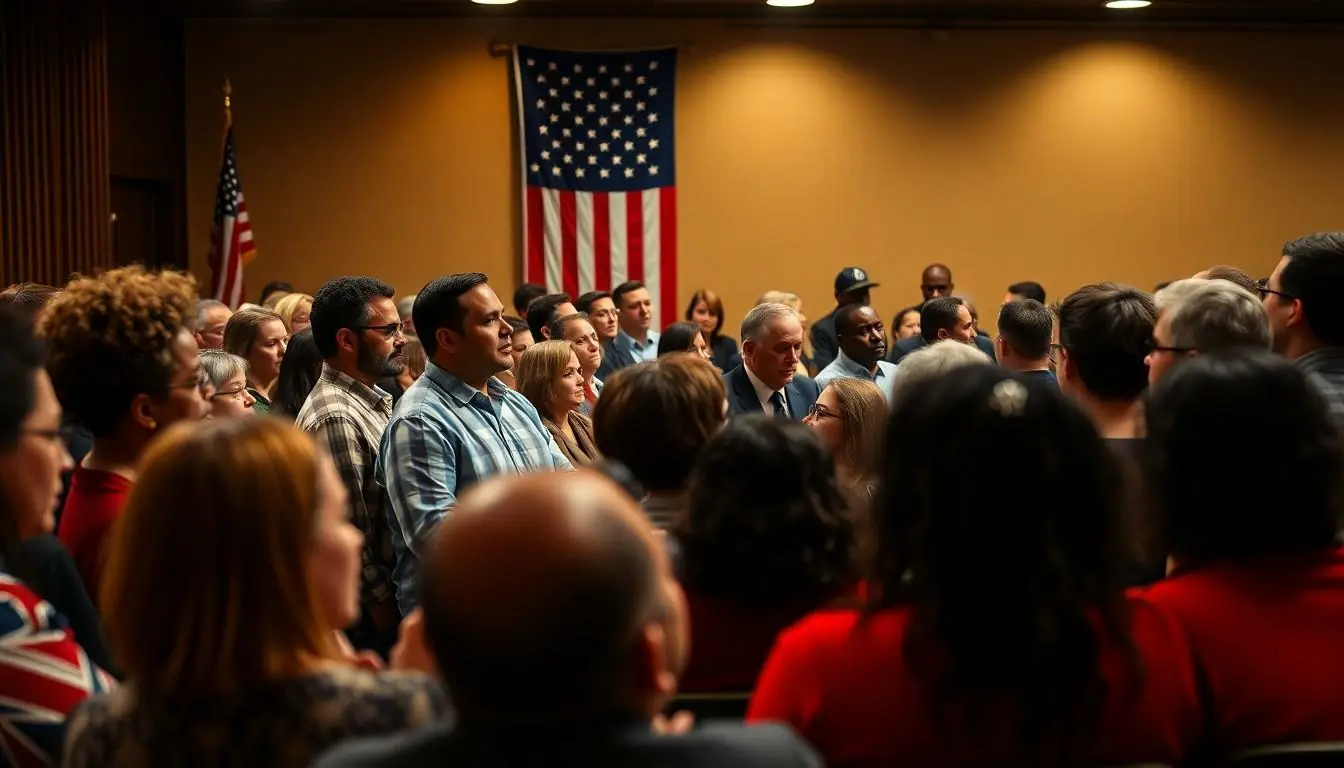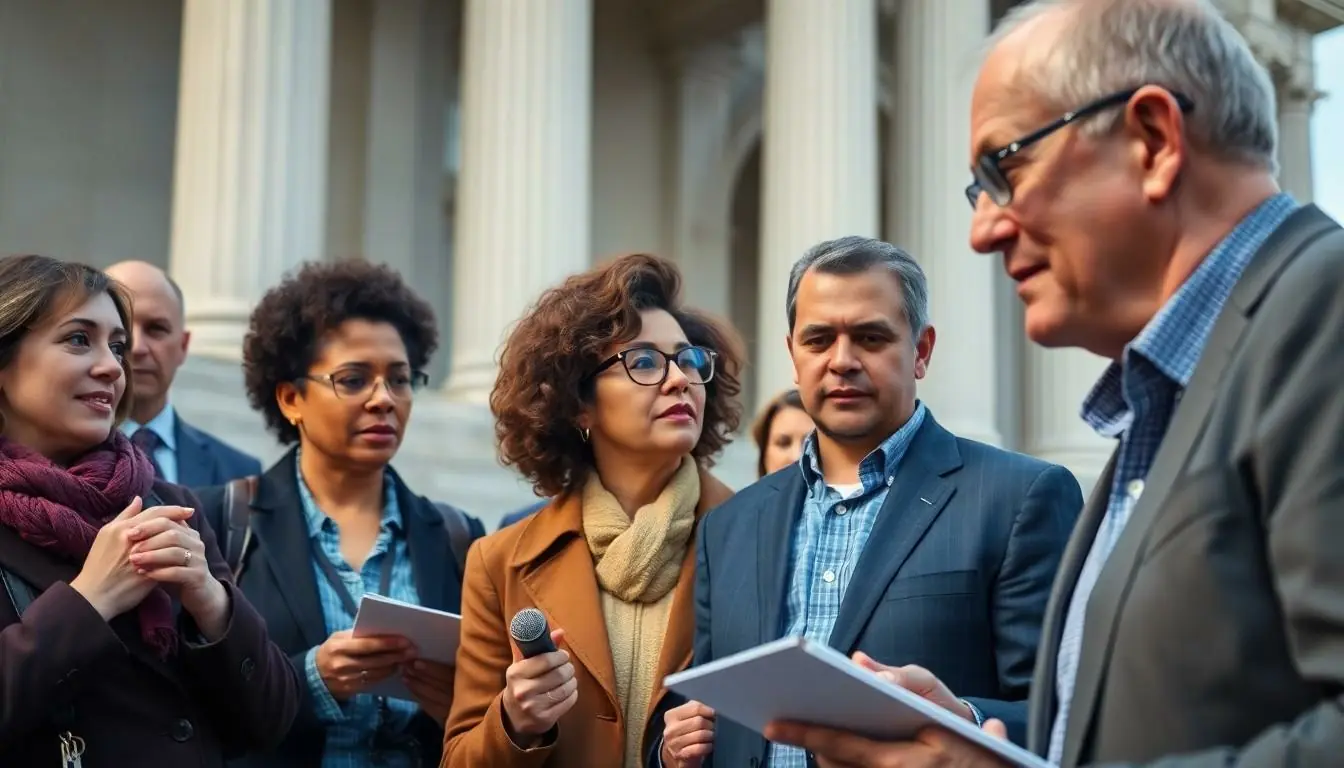In a world where policy decisions can feel as distant as the moon, the media steps in like a trusty sidekick, bringing clarity to the chaos of lawmaking. They sift through the legalese and political jargon, translating it into bite-sized nuggets that even your pet goldfish could understand. By covering policy and the lawmaking process, the media doesn’t just inform—they empower the public to engage in conversations that matter.
Think of the media as the ultimate backstage pass to the political show. They shine a spotlight on the decision-makers, exposing the good, the bad, and the downright ridiculous. With every article and broadcast, they provide the public with essential insights, turning complex issues into relatable stories. So, the next time you catch a news segment on policy, remember: it’s not just information; it’s your ticket to being an informed citizen in this wild ride of democracy.
Table of Contents
ToggleOverview of Media Coverage
Media coverage plays a vital role in clarifying the lawmaking process. It transforms complex legal terms into accessible information. Audiences gain insights into policy decisions through comprehensive reporting by journalists. Reporters often investigate the motivations behind legislative actions, shedding light on governmental transparency.
Public interest stories highlight the implications of new laws and policies. By breaking down these issues, the media encourages informed debate among citizens. Coverage of debates and hearings allows the public to witness decision-making firsthand. Analysis of proposed legislation equips citizens with the tools needed for understanding its impact.
Timely updates serve as a resource for those seeking to stay informed about current events. Journalists often follow up on the outcomes of legislation, holding lawmakers accountable for their promises. In-depth investigations uncover potential biases or conflicts of interest, reinforcing journalistic integrity.
Editorial pieces provide context and differing perspectives on critical issues. They facilitate conversations around policy, encouraging diverse viewpoints. Multimedia formats, such as podcasts and videos, offer engaging ways to explore complex legal topics.
Social media amplifies the reach of this information, enabling wider public engagement. Governments and organizations can also use these platforms to communicate directly with constituents, fostering dialogue. Overall, media coverage is essential for enhancing public understanding of the lawmaking process and its significance within a democratic society.
Importance of Policy Coverage

Media coverage plays a significant role in keeping the public informed and engaged in the lawmaking process. It provides essential insights into policy decisions and the overall functioning of government.
Informing the Public
Educating citizens about legislative actions serves as a primary function of the media. Reporting on proposed laws and policy changes helps audiences understand their implications. Journalists explain legal jargon clearly, making it accessible. They present stories that reflect the real-life impact of policies on various communities. Regular updates ensure the public stays aware of developments. Collaborative efforts with experts elevate the quality of information shared. Media platforms encourage public discourse, allowing diverse perspectives to surface. Engaging formats, such as articles or videos, bring complex subjects to life.
Enhancing Transparency
Providing transparency in governance stands as another essential role of media coverage. Journalists investigate motivations behind legislative decisions, unveiling potential biases. They hold lawmakers accountable through follow-up reporting on promises made during campaigns. Coverage of debates and public hearings allows citizens to observe decision-making processes firsthand. Analyzing legislation fosters a deeper understanding of its societal impact. This scrutiny builds public trust in governmental institutions. Editorials offer context and different viewpoints, stimulating informed discussions. Utilizing multimedia elements enhances the clarity of complex legal topics. Ultimately, robust media engagement strengthens democracy by promoting accountability and transparency.
The Lawmaking Process Explained
The lawmaking process involves several key stages that shape policies and influence governance. Many factors contribute to how laws emerge and evolve.
Key Stages in Lawmaking
First, the proposal of legislation marks the beginning. This stage often includes drafting by lawmakers or public interest groups. Following the proposal, committees review the legislation, holding hearings to gather expert opinions. Amendments may occur during this phase, adjusting the bill to better address concerns. Once committees recommend a bill, it moves to the floor for debate among all legislative members. Voting occurs after discussions, determining the bill’s fate. If passed, it goes to the executive branch for approval or veto. Each stage influences the final outcome and reflects the interests of the public.
Role of the Media in Lawmaking
The media plays an essential role throughout the lawmaking process. They report on proposed legislation, making complex information accessible to citizens. Critical analysis from journalists sheds light on the implications of new laws. Coverage of debates allows the public to witness decision-making in real-time. Investigative reports reveal potential conflicts of interest, promoting transparency and accountability. Editorial pieces provide context and diverse perspectives, stimulating informed discussions among the public. Multimedia formats engage audiences, making legal topics relatable. Through timely updates, the media keeps citizens informed and encourages participation in democracy.
Impact on Public Perception
Media coverage significantly shapes public perception of policy and the lawmaking process. People often rely on journalists to present complex issues in an understandable manner. Clear explanations enhance citizens’ engagement with political matters, leading to more informed discussions.
Accountability becomes a priority when investigative reporting reveals the motivations behind decisions. Insightful articles raise awareness about potential biases and conflicts of interest, fostering public trust in the media. Furthermore, timely updates on legislative actions keep citizens informed about current developments, facilitating real-time conversations.
Public interest stories serve to highlight the implications of new laws, affecting communities directly. By focusing on tangible outcomes, the media allows individuals to grasp how policies influence their daily lives. Engaging formats, such as podcasts and videos, make complex legal topics more accessible and relatable.
Some may find editorial pieces offer diverse perspectives, enriching the discourse surrounding crucial issues. They encourage readers to consider multiple viewpoints, vital for healthy public debate. Coverage of debates and hearings lets audiences witness the lawmaking process firsthand, deepening their understanding.
Visual and social media platforms help broaden public dialogue about policy matters. These channels amplify reach and encourage participation from a wider audience. Overall, the media plays an essential role in not just informing the public, but also empowering them to engage actively in democracy.
Challenges Faced by the Media
The media encounters several challenges while covering policy and the lawmaking process. Misinformation poses a significant threat, as inaccuracies can distort public understanding of legislative matters. Journalists often struggle to verify facts amidst the rapid spread of information on digital platforms.
Complex legal jargon complicates reporting on legislative issues. Access to policymakers can be limited, making it difficult for reporters to obtain valuable insights regarding proposed laws. Additionally, they face pressure from various stakeholders, including political figures and interest groups, who may attempt to influence coverage.
Competition in the media landscape further hinders thorough investigative reporting. The demand for quick news often prioritizes sensational stories over in-depth analysis of policies. Resources can be scarce, impacting the ability to dedicate sufficient time and energy to comprehensive investigations.
Balancing the need for impartiality while addressing public interests creates another layer of complexity. Journalists must navigate editorial pressures with personal biases, weighing the angles they choose to present. Journalistic integrity often comes into question when news outlets prioritize headlines over accuracy.
Budget constraints limit the scope of investigative journalism, impacting the quality of coverage. Many media organizations receive inadequate funding for robust reporting initiatives that expose potential biases or conflicts of interest. This situation reduces the capacity to provide extensive, well-researched insights into complicated legislative frameworks.
Engagement through visual and interactive content also presents challenges. Many media outlets struggle to innovate while maintaining transparency and accountability, often feeling constrained by traditional formats. Ultimately, these challenges significantly affect how the media informs the public about policy and the lawmaking process.
The media’s role in covering policy and the lawmaking process is indispensable for fostering an informed public. By translating complex legal concepts into accessible language they empower citizens to engage meaningfully in democratic discourse. This coverage not only enhances transparency but also encourages accountability among lawmakers.
As the media continues to navigate challenges like misinformation and resource constraints it remains crucial in shaping public perception. Through diverse formats and investigative reporting the media ensures that the implications of policies are understood. Ultimately the ongoing relationship between the media and the public is vital for a thriving democracy where informed citizens can actively participate in shaping their governance.




